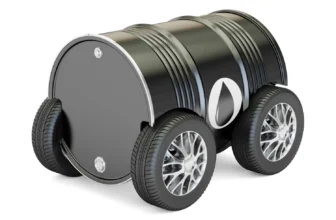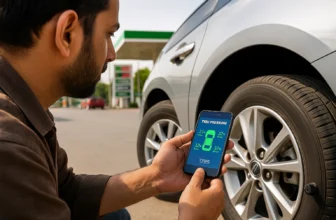
If your car’s AC hits you with a musty, gym-locker smell every time you turn it on—especially after a hot day in Karachi—you’re probably blaming the wrong part. It’s not the cooling gas, not the vents, and not your floor mats. The real culprit? Your cabin air filter. And chances are, you didn’t even know your car had one.
In Pakistan, most drivers overlook this small yet critical component. But in cities like Karachi, Lahore, and Faisalabad—where humidity, dust, and pollution are part of everyday traffic—the cabin filter is the first line of defense against bad smells, poor air quality, and long-term AC damage. This guide explores why the cabin air filter is often ignored, what damage it can silently cause, and how to stay ahead of it with simple, affordable maintenance.
What Is a Cabin Air Filter—and Why Does It Matter?
Think of the cabin air filter as your car’s lungs. It sits behind the glove box or inside the dashboard vent system, filtering the outside air before it enters the AC and gets blown into your face. This filter traps:
- Dust and dirt from traffic and construction zones
- Pollen and allergens that affect breathing
- Smog and vehicle exhaust fumes
- Even bacteria, spores, and mold particles in some cases
In a city like Karachi—where vehicle emissions and coastal humidity combine into a perfect storm—this filter can become overloaded fast. Once clogged, it not only stops working but starts becoming a problem itself, creating a breeding ground for mold and bad odor that circulates through your vents every time the AC runs.
How Dirty Cabin Filters Cause Smells, Mold & Allergies
When your cabin air filter is left unchanged for months—or years—it turns into a damp, dirty sponge full of contaminants. In hot, humid environments like Karachi and Hyderabad, moisture gets trapped in the filter material, feeding the growth of fungus and bacteria.
This leads to:
- Musty or “sweaty” smells whenever AC is turned on
- Frequent window fogging due to poor air circulation and humidity buildup
- Health issues: Sinus irritation, sneezing, headaches—especially in allergy-prone passengers
- AC blower strain: A clogged filter makes the fan motor work harder, reducing lifespan and airflow
Drivers often misdiagnose these symptoms as a gas recharge issue or think they need a full AC service. In reality, a simple filter change could fix it all—and costs far less.
Signs Your Cabin Filter Needs Replacement
Unlike engine issues, a dirty cabin filter won’t trigger a warning light—but the symptoms are hard to ignore if you know what to look for. Here are the most common signs Pakistani drivers should watch out for, especially in cities like Lahore, Karachi, and Rawalpindi:
- Bad Smells at AC Startup: A damp, mildew-like odor hits as soon as you turn the fan on—especially after the car’s been sitting in heat.
- Weak Airflow: Even at full blast, the vents don’t push out enough air. This is because the blower motor is choking behind a clogged filter.
- Frequent Fogging: Windows fog up even in mild humidity because air circulation is poor and uneven.
- Allergy Symptoms Inside the Car: Sneezing, watery eyes, or breathing discomfort—especially after a drive through dusty areas.
If you’re noticing two or more of these signs, your filter is likely overdue for a change. Many mechanics skip it during service unless asked—so it’s on you to stay aware.
How Often Should You Change Cabin Air Filters in Pakistan?
Globally, most car manufacturers recommend changing the cabin air filter every 15,000 to 20,000 km. But let’s face it—Pakistan isn’t a clean-air country. Between construction dust, urban smog, and post-monsoon grime, the realistic interval here is much shorter.
Here’s a better rule of thumb for local conditions:
- Every 8,000–10,000 km if you drive mostly in cities like Karachi, Lahore, or Islamabad
- Every 6 months if you park in open lots or near construction zones
- After every monsoon season to avoid mold and moisture damage
PakWheels forum discussions often confirm this—many users who changed their filters earlier reported instant improvements in cooling, airflow, and cabin smell. Waiting for the official service schedule in Pakistani conditions? That’s a shortcut to a smelly, suffocating interior.
OEM vs Local vs Chinese Cabin Filters — What’s the Difference?
Not all cabin filters are created equal. From genuine parts to Chinese knockoffs, the Pakistani market is filled with options—but performance and durability vary wildly. Here’s how the most common filter types stack up:
| Brand | Origin | Filter Quality | Approx. Lifespan | Price Range (PKR) |
|---|---|---|---|---|
| OEM (Toyota, Honda) | Japan/Thailand | Excellent (multi-layer, carbon options) | 10,000–15,000 km | 1,800 – 3,000 |
| Guard | Pakistan | Good (decent dust trapping) | 6,000–10,000 km | 600 – 1,000 |
| VIC | Japan | Very Good (strong airflow, durable) | 10,000–12,000 km | 1,200 – 2,000 |
| Chinese Generic | China | Poor (thin media, bad fit) | 3,000–5,000 km | 300 – 700 |
While it’s tempting to go cheap, poor-quality filters can whistle, restrict airflow, or even fall apart inside the housing—causing more damage than they prevent.
DIY or Mechanic? How to Replace Cabin Filters Safely
Replacing a cabin air filter is one of the easiest car maintenance jobs you can do yourself—no pit stop required. Yet, most Pakistani drivers either don’t know about it or let the “ustaad” do it without checking if it was actually done. Here’s how you can change it yourself in popular models like the Suzuki Alto, Honda City, Civic, or Toyota Corolla:
- Step 1: Open the glove box and unclip the side dampers (in most cars) to let it drop fully.
- Step 2: Locate the rectangular plastic filter housing—usually behind the glove box or AC panel.
- Step 3: Slide out the old filter and inspect it. If it’s grey, dusty, or has leaves/insects, it’s time to replace.
- Step 4: Insert the new filter in the correct direction (airflow arrows matter).
- Step 5: Reassemble the glove box and run the AC for 2 minutes to check for airflow and smell.
Pro tips:
- Use a handheld vacuum to clean the filter housing before inserting the new one.
- Always check the fit—too tight or too loose means you’re using the wrong size.
- Stick to trusted brands (VIC, Guard, OEM) to avoid noisy airflow or poor sealing.
If you’d rather have it handled during service, insist the mechanic shows you the old filter. Many will skip it altogether unless you ask directly.
Conclusion
The cabin air filter is a small, often-overlooked part of your vehicle—but it has a big impact on comfort, health, and cooling performance. In Pakistan’s hot, dusty, and humid climate, neglecting this filter means living with bad smells, blocked airflow, and a breeding ground for allergens inside your car.
Whether you’re driving daily in Karachi’s sea breeze, through Lahore’s construction clouds, or across Islamabad’s tree-lined roads, changing your cabin air filter every few months is one of the cheapest, smartest upgrades you can make. Your nose—and your AC system—will thank you.
While TyrePoint.pk focuses on tyres, not cabin filters, we believe in complete driving comfort—inside and out. Browse our summer and all-season tyre collection, engineered for better grip, less cabin noise, and smoother rides on Pakistan’s tough roads.






